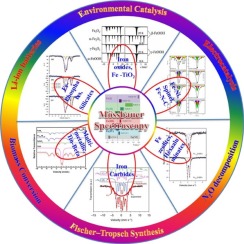Applied Catalysis B: Environment and Energy ( IF 22.1 ) Pub Date : 2017-11-03 , DOI: 10.1016/j.apcatb.2017.11.004 Xuning Li , Kaiyue Zhu , Jifeng Pang , Ming Tian , Jiayi Liu , Alexandre I. Rykov , Mingyuan Zheng , Xiaodong Wang , Xuefeng Zhu , Yanqiang Huang , Bin Liu , Junhu Wang , Weishen Yang , Tao Zhang

|
Their wide availability in nature, low cost, high reactivity, and low toxicity make Fe-based catalysts versatile in various catalysis fields, including photocatalysis, Fenton-like reaction, electrocatalysis, Li-ion batteries (LIBs), Fischer–Tropsch synthesis (FTS), biomass conversion, N2O decomposition and etc. Mössbauer spectroscopy, a powerful technique that is able to give account of structural features for all iron species taking part in the catalysis process, is considered to be a crucial technique for determining catalyst phase, identifying active site, and investigating correlations between catalytic behavior and the coordination structure of catalysts, which are highly desirable for clarifying the catalytic mechanisms. Each kind of Fe-based materials could be functionalized in the most suitable catalysis field, wherever Mössbauer technique may play a unique role. For instance, Fe-N-C based materials are extensively investigated as electrocatalysts for oxygen reduction reaction and Mössbauer spectroscopy application in this field has been utilized to identify the chemical nature of the active site on the Fe-N-C catalyst. Iron carbides are considered as the most active phase for FTS and Mössbauer technique is widely applied in determining the chemical phase of catalysts. Fe-based silicates, phosphates or polyanionic compounds are recognized as promising cathode materials for LIBs, for which Mössbauer technique has been mainly applied for tracking of the oxidation state and coordination environment change of Fe between charged and discharged states of the batteries. Similar phenomena can also be found in other catalysis fields. To give a clear understanding of which field is most suitable for a certain Fe-based catalyst and the best role of the Mössbauer technique in a certain catalysis field associated with the investigation of the mechanism, in this review, the recent advances of applying Mössbauer technique in catalysis are thoroughly summarized, including results from environmental catalysis and energy catalysis. Remarkable cases of study are highlighted and brief insight into applying Mössbauer technique for various Fe-based materials in their special catalysis field is presented. Finally, the trends for future potential applications of Mössbauer technique are discussed.
中文翻译:

Mössbauer光谱在评估非均相催化剂结构特征方面的独特作用
铁基催化剂在自然界中的广泛可用性,低成本,高反应活性和低毒性使其在各种催化领域中具有广泛用途,包括光催化,类Fenton反应,电催化,锂离子电池(LIB),费托合成(FTS) ),生物量转化,N 2O分解等。Mössbauer光谱法是一种强大的技术,能够考虑所有参与催化过程的铁物种的结构特征,被认为是确定催化剂相,鉴定活性位点和研究相关性的关键技术。催化行为和催化剂的配位结构之间的关系,这对于阐明催化机理是非常需要的。无论哪种Mössbauer技术可能发挥独特作用,每种类型的Fe基材料都可以在最合适的催化领域中进行功能化。例如,已广泛研究了基于Fe-NC的材料作为氧还原反应的电催化剂,并且已利用该领域的穆斯堡尔光谱技术来鉴定Fe-NC催化剂上活性位的化学性质。碳化铁被认为是FTS活性最强的相,Mössbauer技术被广泛应用于确定催化剂的化学相。铁基硅酸盐,磷酸盐或聚阴离子化合物被认为是锂离子电池的有前途的正极材料,为此,穆斯堡尔技术主要用于跟踪电池的充放电状态下铁的氧化态和配位环境的变化。在其他催化领域中也可以发现类似的现象。为了清楚地了解哪个领域最适合某些铁基催化剂,以及穆斯堡尔技术在与该机理研究相关的某些催化领域中的最佳作用,在本文中,本文综述了运用穆斯堡尔技术的最新进展在催化方面进行了彻底的总结,包括环境催化和能量催化的结果。重点介绍了杰出的研究案例,并简要介绍了将Mössbauer技术应用于特殊催化领域中各种铁基材料的见解。最后,讨论了Mössbauer技术未来潜在应用的趋势。



























 京公网安备 11010802027423号
京公网安备 11010802027423号